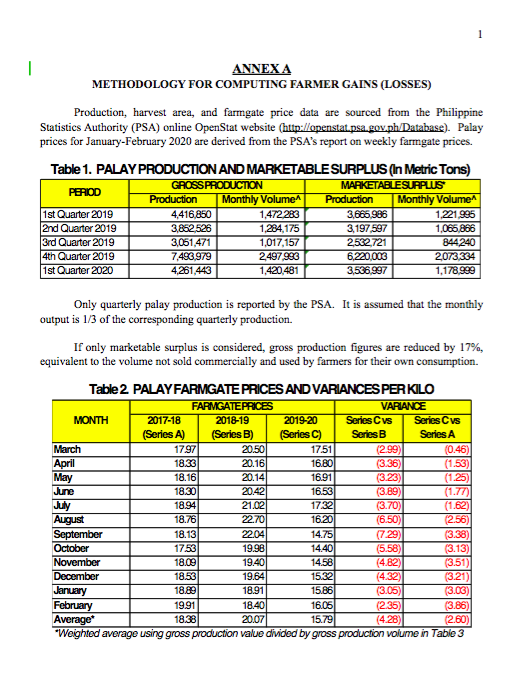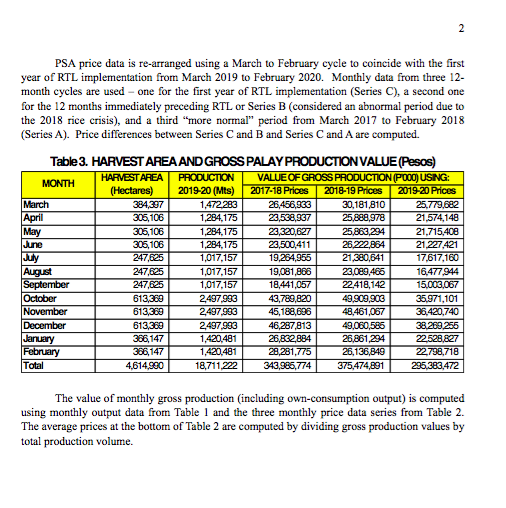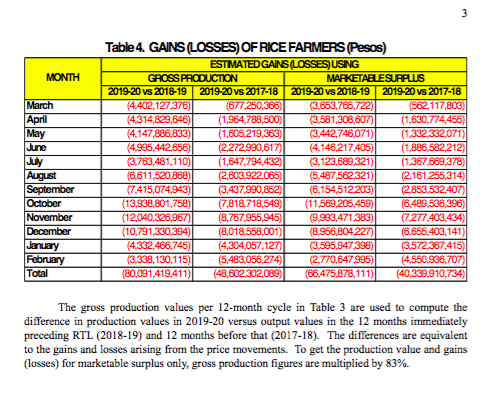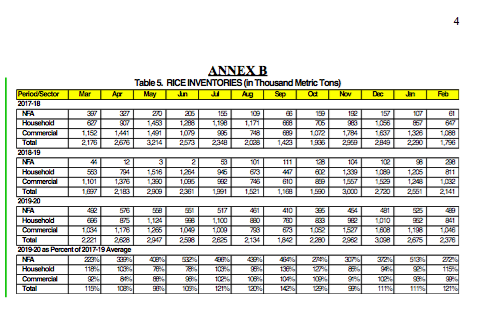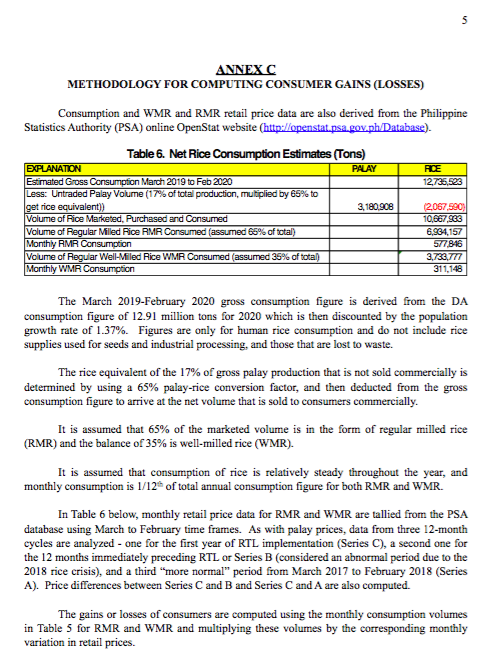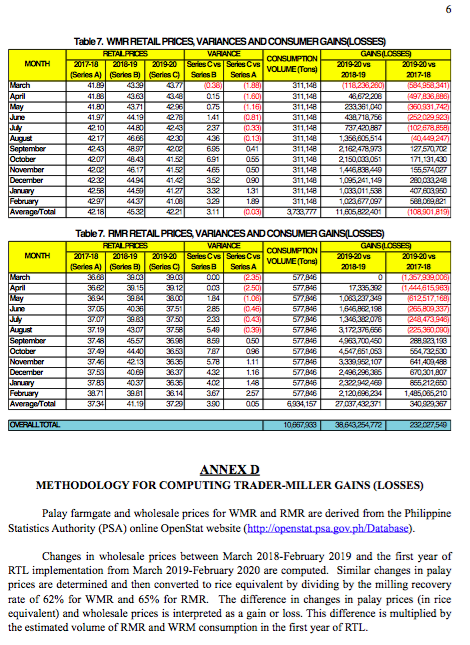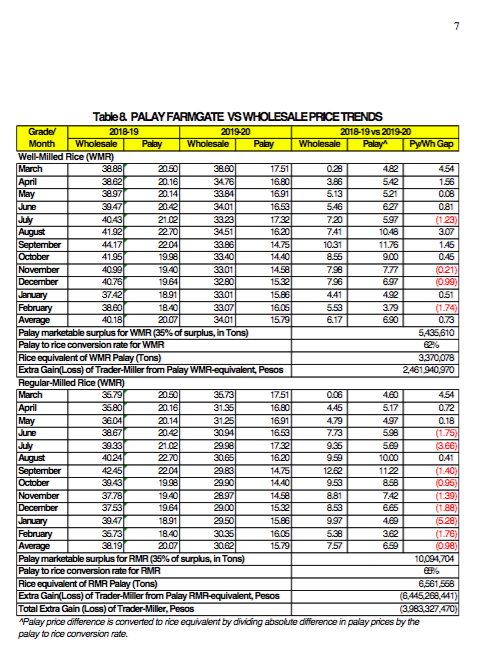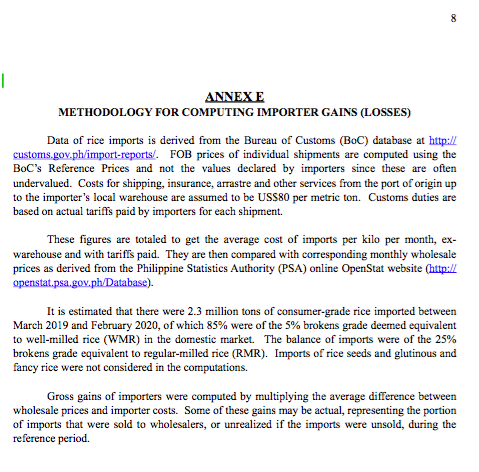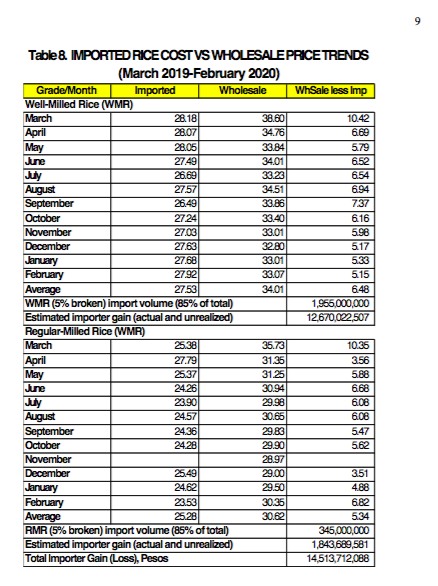Winners and losers from the rice tariffication law
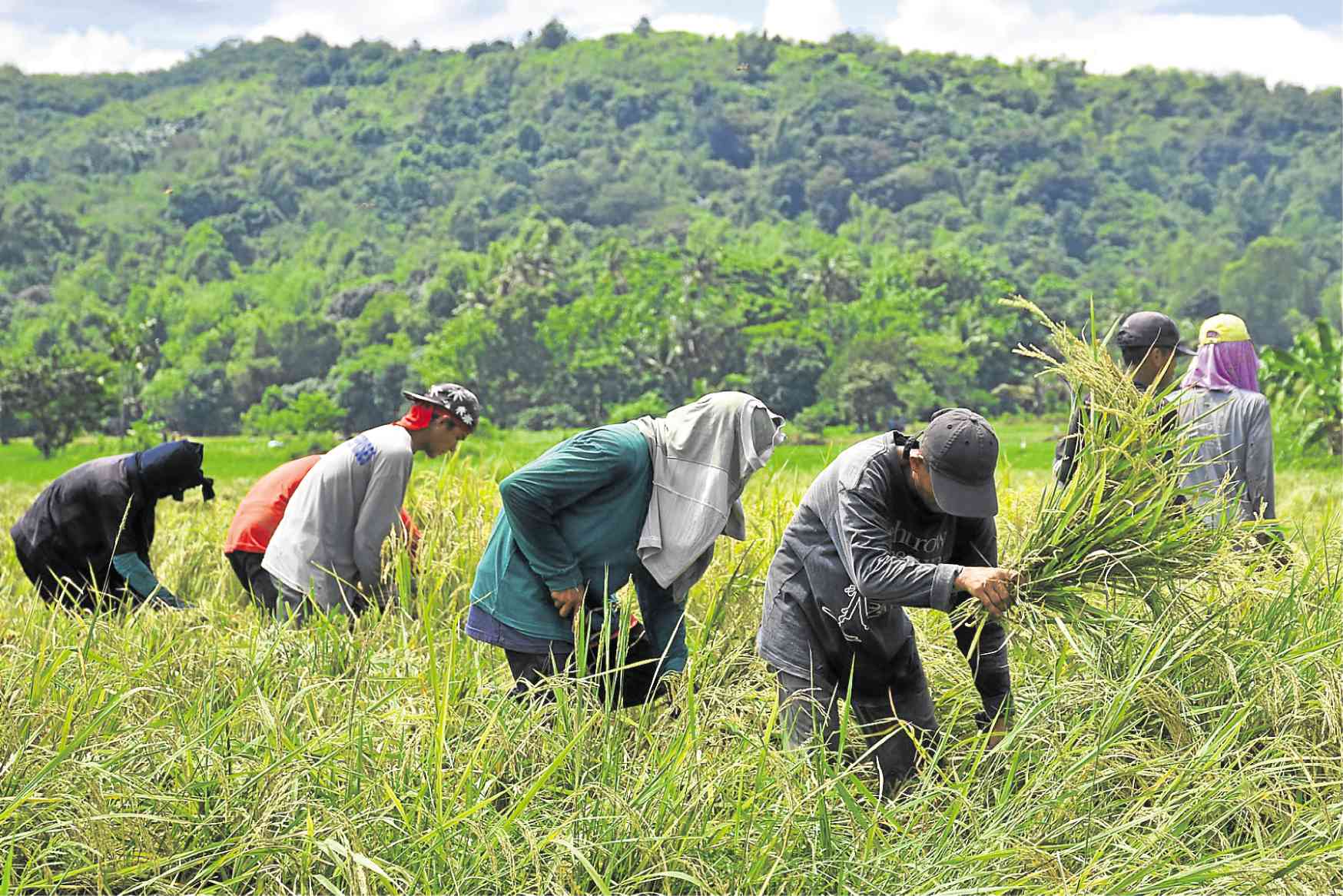
It would seem that planting rice would never be fun, especially for hundreds of thousands of farmers who had stopped the backbreaking work in the field because of falling prices of the staple resulting from import liberalization. —WILLIE LOMIBAO
In recent weeks, several staunch advocates of the liberalization of the rice sector released a series of opinion pieces, touting the alleged gains from Republic Act No. 11203 or the Rice Tariffication Law (RTL) and debunking the claims of critics of the law and its implementation. This paper seeks to set the record straight by assessing what really happened, using mutually acceptable assumptions and more precise calculations, with the hope that the findings will point policy makers and stakeholders in the rice industry to a more realistic and productive way forward.
Recap
To review, RA 11203 was signed by President Rodrigo Duterte on February 14 and took effect on March 5, 2019. The law removed government limits, called quantitative restrictions (QRs) on rice importation. Traders could now bring in unlimited volumes of rice at any time. RA 11203 far exceeded Philippine commitments to the World Trade Organization (WTO) by deregulating the rice industry and eliminating practically all regulatory and trading functions of the National Food Authority (NFA) and reducing it to a buffer stocking and calamity relief agency. Aptly, the formal title of RA 11203 is “An Act Liberalizing the Importation, Exportation and Trading of Rice”.
Following WTO’s tariffication procedure, rice QRs were replaced by tariffs, most notably the 35% preferential duty that the Philippines had previously imposed on imports from ASEAN countries. RA 11203 also created the Rice Competitiveness Enhancement Fund (RCEF), amounting to Php 10 billion annually for six years, to assist rice farmers with seeds, farm machineries, credit and technical extension.
In the lead up to RA 11203, many RTL proponents prophesied that import liberalization would significantly lower domestic rice prices, tame inflation, and moderate malnutrition and poverty. While acknowledging that farmers would get hurt in the immediate term, they promised even larger benefits to consumers, including those farmers who were net rice buyers.
Article continues after this advertisementThe question now is: Did this trade-off, described as a “no brainer” by then Director-General Ernesto Pernia of the National Economic and Development Authority (NEDA), actualy happen during the first year (March 2019 to February 2020) of RTL’s implementation?
Article continues after this advertisementIn brief, no! This analysis shows that rice farmers suffered drastic losses, which far surpassed any gains to consumers. In addition, a few importers and big-time traders cornered tremendous profits from rice trade liberalization at the expense of millions of farmers, millers and other market players, who were swamped by the deluge of cheap and undervalued rice imports. RTL came out to mean “Rice Traders Liberated, at last!”
In 2019, with nearly three million tons of imported rice, the Philippines overtook China and received the dubious honor of being the world’s biggest rice importer.
As stated previously, RTL seriously clipped government’s supervision over the rice industry and effectively ceded control to the private sector. By doing so, it has undermined its capacity to stabilize the rice market, safeguard producer and consumer welfare, ensure food safety, and sustain efforts aimed at food security.
How did farmers fare in the first year of RTL?
Analyzing the situation further, let us first tackle the impact of trade liberalization on farmers. Earlier, the Federation of Free Farmers (FFF) and other groups had estimated that rice producers lost around Php 80 billion in 2019 due to palay prices plumneting from a high of Php 23.14 per kilo in September 2018 to a low of Php 15.36 in 2019. A more precise recalculation, using monthly price and production data from the Philippine Statistics Authority (PSA), yields practically the same outcome. (See Annex A.) Coincidentally, the results are close to PSA’s own computation of a Php 87 billion reduction in the palay sector’s value of production in 2019 compared to the previous year.
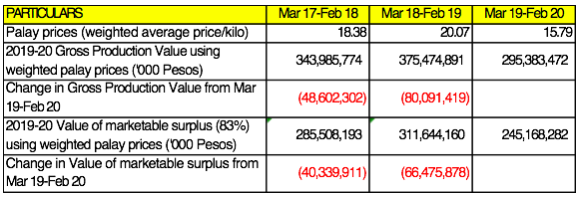
With RTL in place in early March, another 2 million tons arrived during the next seven months. This created a serious glut that, by September 2019, raised national stocks to 42% over historical levels. (See Annex B.) The oversupply coincided with the peak of the main harvest season in October and November, making it difficult for traders to dispose of their stocks in a market flooded with imported rice. Some suspended their operations; others continued buying palay, but at deeply discounted prices. Prices plunged further to an average of Php 14.40 per kilo in October.
Prompted by farmers groups, in September 2019, the DA initiated an investigation on possibly imposing safeguard duties to stem the flow of imports. Inexplicably, the DA ended its study and refused to apply a provisional safeguard duty allowed by law. Instead, it tightened the issuance of sanitary and phytosanitary import clearances. Meanwhile, the NFA and local government units intensified their palay buying operations. By then, however, most of the damage had already been done.
Pro-RTL proponents have criticized the estimates of farmers’ losses as exaggerated, noting that the latter used an annual (January to December) data series, instead of a March to February data cycle that would match the implementation period of the RTL. They added that prices should not be compared to rates in 2018, which was a crisis year during which rice prices were abnormally high. Further, they argued that only the 83% of production thatfarmers actually sold in the market, called marketable surplus, should be used in the computations, since the 17% that they kept for their own consumption was not affected by any movement in market prices.
Before responding to these observations, it should be emphasized that the Php 80 billion loss estimate was accurate and real if palay prices during the first year of RTL were compared to prices in the same 12 month period of the previous year. Farmers did incur a drop in their income equivalent to Php 80 billion compared to what they earned in the preceding 12 months. Furthermore, the palay that farmers did not sell commercially was an asset whose value could go up or down while in storage. This change in value could still be reasonably treated as an imputed gain or loss.
Nevertheless, we proceeded with our recalculations, using March 2017-Feb 2018 (instead of March 2018-February 2019) as the reference period and recognizing only the marketable surplus of farmers. With these adjustments, farmers’ losses during RTL’s first year will be halved to about Php 40 billion. This number is still significantly large. Notably, it approximates the Php 38.4 billion in losses estimated by NEDA’s Philippine Institute of Development Studies (PIDS) when using a similar reference period.
RTL defenders further argue that farmers’ net losses would just be Php 6 billion if government support to them is taken into account. However, their idea of fully crediting the Php 10 billion RCEF for 2019 is illogical, because only about Php 3 billion were actually given to farmers, mainly in the form of free seeds. Oddly, they also want to deduct in full the RCEF, SURE-Aid and other soft loans, which farmers have to pay back. If ever, only the interest subsidy should be considered a benefit, and this will be minimal since only around Php 4 billion were actually lent out to farmers. While Php 3 billion were given separately as partial compensation for lost income under RTL, only one-fourth of all farmers qualified for this Php P5,000 assistance. Overall, the creditable subsidies actually received by farmers would amount to about Php 6 billion. Farmers would still end up with a consolidated loss of Php 34 billion. The RTL proponents are duty-bound to show how they arrived at a considerably smaller net loss figure of Php 6 billion.
Clearly, farmers were worse off in the first year of RTL. On average, palay prices under RTL were Php 4.28 per kilo lower than those in the preceding 12-month period (March 2018 to February 2019). Even against the more “normal” period from March 2017 to February 2018, farmgate prices were still by Php 2.60 per kilo. Cumulative losses from gross palay production amounted to about Php 80 billion when comparing pre- and post-RTL prices; and half of that (Php40 billion) when using 2017-18 prices as reference and counting only marketable surplus. Compared to the 12-month period preceding RTL, farmers’ incomes dropped by 21%, or Php 17,355 per cropping per hectare on the average.
Did consumers gain due to RTL as promised?
This, however, is only half of the story. Pro-RTL advocates had theorized that consumers would be the biggest winners under rice liberalization. The question is: were they?
In recent opinion posts, the Department of Finance (DoF) was cited as having determined that consumers gained around Php 21 billion from lower rice retail prices following RTL’s enactment. However, DoF must explain how it reached this figure.

But even with the higher estimates, the Php 38.6 billion gain of consumers in terms of lower rice prices still pales in comparison to the Php 80 billion that farmers lost due to depressed palay prices when using the same reference period. Additionally, the Php 38.6 billion translates to a measly saving to each rice consumer of only about Php 1.00 per day.
To be consistent, however, we also compared prices during the first year of RTL against prices in March 2017 to February 2018, given that the 12 months immediately preceding RTL were abnormal times as maintained by RTL proponents. We likewise excluded the rice equivalent of the palay output that farmers kept for their own consumption, since this quantity was not directly affected by the movement in rice prices.
Results show that benefits to our 108 million consumers totaled only Php 232 million, inasmuch as retail prices for both RMR and WMR rice hardly changed relative to prices during the comparative period. (See Annex C.) In effect, each rice-consuming Filipino was able to save a measly Php 2 in one whole year of initial RTL implementation.
Given these analytical findings, the “no brainer” theory about consumers’ gains far outweighing rice farmers’ losses under RTL appears to have been disproven resoundingly. Even with the computational adjustments prescribed by RTL adherents, farmers still lost Php 34 billion, or more than 150 times what consumers gained from rice liberalization.
The DoF has also reportedly claimed that, aside from cheaper rice prices, consumers gained another Php 42 billion due to lower overall inflation. It is unclear why this should enter the discussion. Rice consumption accounts for only about 10% of the consumer basket. Lower rice prices help lower the overall inflation rate and result in savings to consumers which have already been quantified above. The other 90% of the inflation rates comes from purchases of fish, meat, and other consumer products and services. The movement in the prices of these items is not dependent on the prices of rice. Therefore, any additional benefit to consumers arising from the lowering of prices of non-rice items cannot be attributed to the RTL.
Even before the rice crisis in late 2018, many government officials and economic advisers were already predicting that rice prices would go down by Php 7 to 10 per kilo once imports were liberalized. One NEDA official boldly announced that private importers would be selling rice below the NFA-subsidized price of Php 27 per kilo. PSA data confirm that retail prices for both RMR and WMR decreased significantly from their peak in September 2018. But when matched against prices during a more normal period (March 2017 to February 2018), retail prices hardly moved under RTL. In other words, consumers were no better off under RTL.
Official PSA data also reveal that much of the drop in retail prices from their peak in September 2018 actually occurred before RTL took effect in March 2019. After government allowed additional imports during the rice crisis in late 2018, WMR prices immediately dove by 9.4% to Php 44.37 per kilo by February 2019. In the next twelve months coinciding with the first year of RTL, prices fell further, but only by an additional 6.7%. Similarly, 60% of the reduction in RMR retail prices occurred before RTL took effect.
So, why did the rosy projections for RTL not materialize?
First, the claims that Filipinos were paying twice or triple what consumers in other countries were spending for rice were deceptive and overblown. Free on Board (FOB) export prices cannot be compared to domestic wholesale rates because the foreign rice still has to be shipped, taxed, warehoused, handled and sold before reaching local wholesalers. Moreover, major exporters like Thailand and Vietnam have to sell their surplus stocks at a relatively low price so that they unload their inventories before new harvests come in. Consumers in these countries do not enjoy these discounted export prices. One Internet publication suggests that rice retail prices are actually higher in Thailand and only about 20% lower in Vietnam compared to the Philippines. Even imported fancy varieties like Thai Jasmine rice are sold locally for as much as 40% more than our local Dinorado or Sinandomeng rice.
Secondly, NFA and its subsidized Php 27 rice disappeared from the retail market soon after RTL’s passage. The agency is now limited by its RTL mandate to keep most of its stocks in reserve for emergencies and has decided to service only the needs of LGUs and government offices during the current COVID-19 crisis. Private traders and importers did fill in the gap left by NFA in the market, but the equivalent rice grade they supplied was sold at an average of Php 37.29 per kilo. This was almost the same as the price two years back, and Php 10 more per kilo than NFA’s former selling price.
Thirdly, around 85% of total rice imports during the first year of RTL were WMR with 5% brokens. Few importers ordered the RMR with 25% brokens that NFA used to import and sell to poorer buyers. Although WMR was around Php 1.50 more expensive per kilo to import, it could be sold for an average of Php 5 per kilo more than RMR in the domestic market. Understandably, importers brought in more expensive grades that could be sold with a higher profit margin, unlike the NFA which was willing to forego profits and even lose money in order to serve needy consumers with lower quality but cheaper rice.
Fourthly, there was excessive profiteering in the market, and the government, particularly the NFA (whose power to license, monitor and regulate private traders had been eliminated by RTL) was helpless about it. The analysis in the next section on traders’ profits indicates that there were huge variances between import and wholesale prices and between wholesale and retail prices, but a large portion of the difference was not passed on to consumers and was instead pocketed by the traders.
The government’s attempts to impose Suggested Retail Prices (SRPs) on both local and imported rice appear to have been ineffective. Not much has been heard about the publicized commitments of the Philippine Competition Commission (PCC), the local price councils, and other government agencies to run after cartels and price manipulators. It appears therefore that, contrary to what RTL proponents predicted, traders and importers did not openly compete with each other to bring down prices. Instead, they likely agreed not to outprice each other and collectively shoot for the highest prices that consumers could bear.
So, if farmers lost a lot, and consumers gained almost nothing, who won?
Rice Traders Liberated (RTL), At Last!
An additional analysis looked into what happened to market players in between the farmers and the consumers; namely, a) the trader-millers who bought palay from farmers, milled them into rice then sold the rice to wholesalers, b) the importers who brought in stocks from abroad and unloaded them to wholesalers, and c) the wholesalers who passed on the rice to retailers who then sold the staple to final consumers.
Changes in palay buying prices (converted to rice equivalent) were compared to changes in wholesale prices to determine the gains or losses of trader-millers, For WMR, the equivalent prices for palay went down by Php 0.73 per kilo more than the decline in wholesale prices, thus giving trader-millers some extra margin. However, trader-millers lost Php 0.98 per kilo in buying palay then selling the rice output to RMR wholesalers, resulting in an overall loss of almost Php 4 billion for the sub-sector. (See Annex D.)
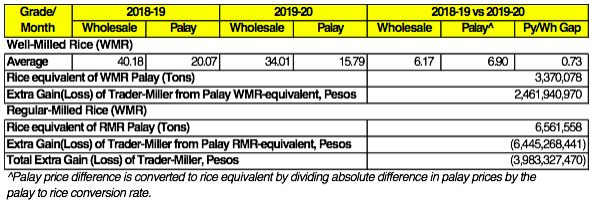
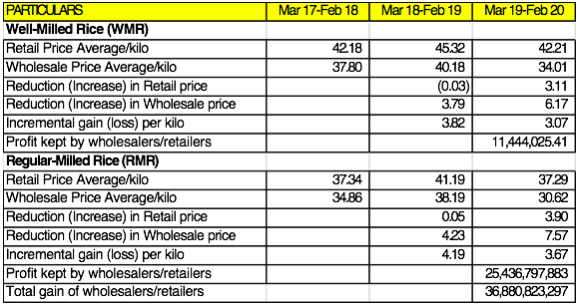
Some of the computed gains may not yet have been realized by importers if a portion of their imported stocks were not yet sold at the end of the first year of RTL. Still, the sizeable margins per kilo and the continued arrival of large volumes of imports indicate that rice importation was a lucrative business. Aside from this, importers were able to save some Php 2.5 billion in tariffs by understating the value of their imports.
Among all the market players however, the big winners were the wholesalers and retailers.
An analysis in the movement of rice prices indicates that while wholesale prices went down due to the inflow of imports in the first year of RTL, only about half of the decrease was passed on to consumers in the form of cheaper retail prices. In the case of WMR for example, wholesale prices went down by Php 6.17 per kilo on the average during RTL, but retail prices declined by only Php 3.11 per kilo. Poorer consumers who bought mainly RMR were worse off since retail prices dropped by only Php 3.90 per kilo even as wholesale rates fell by Php 7.57 per kilo. Using consumption figures between March 2019 and February 2020, this implies that the value chain segment between wholesalers and retailers earned an extra Php 37 billion in windfall profits during the first year of RTL. (See Annex F.)
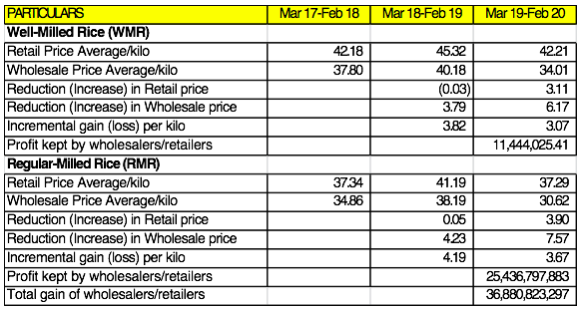
On the average, each Filipino consumer bought and consumed around 100 kilos of rice during the first year of RLT implementation. (This excludes the volume that farmers did not sell commercially and used for their own family consumption.) Of this quantity, 90 kilos came from local farmers while 10 kilos were imported. If the price of local rice goes down by Php 1 per kilo, and trading margins and costs did not change, the value of the palay needed to produce one kilo of rice should also go down by Php 1. Hence, consumer gains would cancel out farmers losses overall. The only variation would come from the 10 kilos of imports, from which consumers gain because of the lower price, but farmers are not affected because they did not produce and sell this quantity. Even then, total consumer gains would not exceed producer losses by a significant amount despite the fact that consumers outnumber farmers by ten to one.
In reality, traders and market intermediaries can distort the parity between consumer gains and farmer losses either by withholding some of the price reduction from consumers or lowering palay buying prices much more than necessary. This is effectively what happened in the first year of RTL wherein farmers lost Php 40 billion while consumers gained a measly Php 232 million. While wholesale prices decreased by an average of 11.4% (when compared to 2017-18 prices) with the arrival of cheap imports, palay prices went down by a larger 14%. Retail prices, on the other hand, hardly budged. In the process, importers, wholesalers and retailers earned a windfall profit of Php 51.5 billion.
Even in the unlikely event that traders donated all of their extra profits to consumers, the latter’s gains would exceed farmers losses by only about P15 billion, admittedly still a significant amount, but nowhere near the huge net gains that RTL proponents had predicted.
It is therefore logical to conclude that any variation in the gains of consumers vis-à-vis losses of farmers arising from trade liberalization will not be influenced by the proportion of consumers to producers. Rather, it will depend on the volume of imports that come in and the relative greed of market intermediaries who will decide how much of the gains they will pass on to consumers and how much of the costs they will ask farmers to absorb.
Did government gain anything from RTL?
Government probably emerged a winner too. It was able to collect around Php 12 billion in tariffs in 2019, despite the undervaluation of import prices, and recoup the Php 10 billion it allocated for the RCEF. It also trumpeted its “success” in bringing down rice prices and overall inflation rates significantly after the 2018 crisis and thereafter keeping rice prices more stable. Still, it was more or less an empty victory because rice prices actually just reverted to their levels before the pre-crisis period.
The fate of NFA is a little harder to figure out. In the past, the agency usually received budgetary support only for its overhead costs and had to borrow from banks to fund its rice imports and local palay purchases. But because it was instructed to buy high from farmers and then sell low to consumers, it usually ended up in huge losses, which it covered by increasing borrowings. As a result, NFA’s debts reportedly ballooned to Php 170 billion.
After RTL took effect, NFA was prohibited from importing rice and was mandated to source its buffer stocks only from local farmers. It was given a higher procurement budget of Php 7 billion annually and still allowed, to some extent, to borrow from banks. However, while NFA sometimes made money and at other times lost about P2 per kilo from past rice imports, it now stands to lose up to Php 10 for every kilo of rice that it sells, if it buys the palay from farmers at Php 19 per kilo. This means that NFA will lose nearly half of its Php 7 billion annual procurement fund after a single buy-palay-sell-rice cycle. After two cycles, the money will be gone, and the agency must resort to bank loans again in order to replenish its buffer stocks. Notably, Php 7 billion can buy the equivalent of only 2% of the country’s rice requirement for one year and can finance only half of the country’s 15-day minimum buffer stock requirement.
The possibility that NFA’s financial condition will not improve, and might even worsen, appears paradoxical, considering that it was its rising indebtedness and continued losses that were highlighted to justify its decapitation under RTL. Critics had further chastised the agency for being inefficient and graft-prone, and questioned its simultaneous role as market regulator and player. These arguments became the basis for transforming RTL from a mere tariffication bill to a unilateral and indiscriminate liberalization statute, whereby the government relegated NFA to the sidelines and surrendered to the private sector the supervision and control of rice importation and the local rice business.
It is worth mentioning that the debate over NFA’s proper role in the rice market helped trigger the rice crisis in 2018 and RTL’s eventual passage. Earlier, the country’s economic managers who sat in the NFA Council had grown increasingly at odds with management, accusing the latter of inefficiency and corruption, especially in the handling of rice imports. They repeatedly denied management’s requests to replenish the agency’s dwindling stocks, until the NFA actually ran out of inventories, and domestic rice prices spun out of control. The Council somehow managed to shift the blame to the Administrator, who was replaced.
Following these developments, there was speculation that the 2018 rice crisis had been orchestrated to pave the ground politically for NFA’s dismemberment and the termination of rice QRs through the RTL.
In sum, there is little to celebrate after one year of RTL’s existence. The promised benefits have not come about, farmers are in dire straits, consumers have practically gained nothing, NFA is still losing money, and government has effectively lost control over the market. Only the importers and traders are smiling, happy to have been “liberated” at last from competition and regulation from the NFA, and free to amass profits with minimal government intervention.
What has to be done?
Clearly, this is neither the result that the government wanted, nor what both farmers and consumers expected. What has to be done, to set things aright?
Several groups have proposed the repeal of the RTL and its replacement with a new law. Others have suggested a major review and amendments to accommodate the following changes:
Strengthen the trade remedy provisions to equip government with WTO-legal tools to address import surges and other injuries that cheap imports can inflict on farmers and local market players. This could include an automatic imposition of special safeguards and a mandatory application of general safeguards once certain conditions are met. The option to temporarily reimpose QRs as a last resort to address serious situations should be approved.
Restore the power of the NFA or any other appropriate government agency to license importers and other players in the rice market, monitor their activities and stocks, and enforce quality, sanitary, phytosanitary, and related market standards.
Adopt stricter measures to prevent the undervaluation and misdeclaration of rice imports; and allow third parties to freely access BoC import data and monitor the entry, pricing, and taxation of imported rice.
Reconfigure the utilization of RCEF to make it more flexible and effective in addressing site-specific needs and emerging priorities of farmers; return control and accountability over RCEF funds and program implementation to the DA proper, while taking steps to improve program delivery and impact.
Reinstate stakeholders’ participation in the planning and monitoring of RCEF and DA Rice Program activities, and establish an on-line implementation monitoring and impact assessment system for programs and activities.
Partially restore the NFA’s role in price stabilization and functions other than buffer stocking when deemed necessary and provide the corresponding budgetary or fiscal support to enable the agency to accomplish its tasks.
While the foregoing analysis shows that the RTL’s performance leaves much to be desired, some RTL proponents have unfortunately tended to brand RTL critics as anti-reformists who just want a return to the QR regime with all its alleged deficiencies and costs. In a recent opinion piece, Dr. Fermin Adriano wrote that his kindest description of RTL’s detractors was “foolish” since they were allegedly offering “no better alternative than to revert back to the old ways”.
Indeed, some RTL critics are demanding a repeal of RA 11203. Others are pushing for its amendments. For sure, all parties do not want to go back to the time when QRs were in place but were used in exchange for government neglect and complacency. But neither will these groups accept the current situation under the RTL. They are not against making farmers more productive, efficient and competitive. However, this will take time because government has long neglected the sector. Opening up the rice market must be calibrated so that farmers can survive while striving to become competitive.
At the same time, it will be foolhardy to be too dependent on foreign suppliers for our rice requirements in the future. Climate change, food safety concerns, pandemics, the rise in trade protectionism, and emerging regional conflicts over water and natural resources can easily constrict the amount of rice that we can buy, or afford to buy, from the international market. In turn, continued land conversion, deforestation, and price volatility brought about by excessive imports will only reduce our capacity to feed ourselves. A more nuanced and strategic approach to liberalization is crucial.
There is nothing “foolish” about this thinking.
Recall that in 1994, highly paid “expert” consultants — employing wrong past analysis, faulty assumptions and economic variables – issued a grievously wrong econometric forecast that Philippine agriculture would be a big winner upon joining the WTO.
Academics like Dr. Adriano tend to go into a denial mode, when actual events go against their pet theories and ideological beliefs. Loath to admit mistakes, they will shrug off any aberration from their predictions as “birth pains” and argue that “it is too early to make conclusions”. They may even resort to childish name calling. Hopefully, they can become humbler, better attuned to the real world, and more open to civil discourse with people they disagree with.
